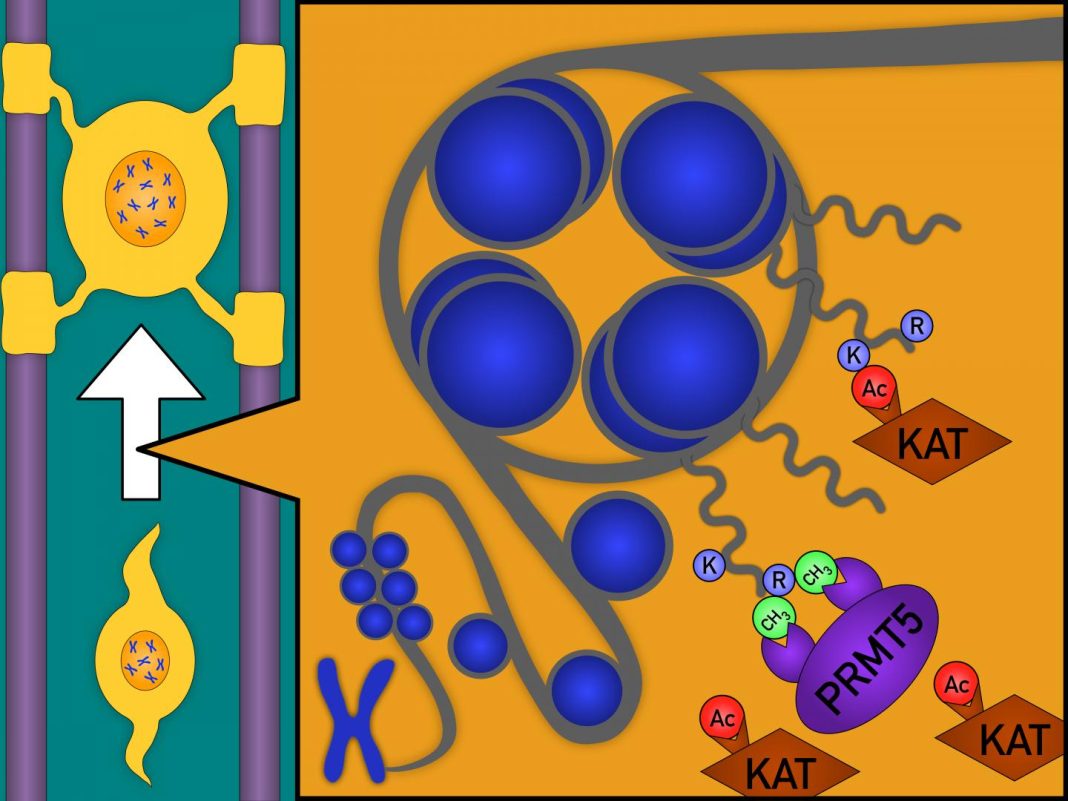Researchers at the Advanced Science Research Center (ASRC) at The Graduate Center of The City University of New York report that they have discovered the role of a protein known as PRMT5 in the production of myelin and, ultimately, proper development and function of the central nervous system. The team hopes to determine how they can create favorable conditions for myelin-forming oligodendrocytes for the purpose of promoting healthy cognitive and behavioral development and identifying novel regenerative strategies for the injured brain which experiences myelin loss after injury (e.g., after stroke or immune attack to myelin, as in multiple sclerosis).
The scientists’ study (“PRMT5-mediated regulation of developmental myelination”) is published in Nature Communications.
“Oligodendrocytes (OLs) are the myelin-forming cells of the central nervous system. They are derived from differentiation of oligodendrocyte progenitors through a process requiring cell cycle exit and histone modifications. Here we identify the histone arginine methyl-transferase PRMT5, a molecule catalyzing symmetric methylation of histone H4R3, as critical for developmental myelination. PRMT5 pharmacological inhibition, CRISPR-cas9 targeting, or genetic ablation decrease p53-dependent survival and impair differentiation without affecting proliferation. Conditional ablation of Prmt5 in progenitors results in hypomyelination, reduced survival, and differentiation. Decreased histone H4R3 symmetric methylation is followed by increased nuclear acetylation of H4K5, and is rescued by pharmacological inhibition of histone acetyltransferases,” write the investigators.
“Data obtained using purified histones further validate the results obtained in mice and in cultured oligodendrocyte progenitors. Together, these results identify PRMT5 as critical for oligodendrocyte differentiation and developmental myelination by modulating the cross-talk between histone arginine methylation and lysine acetylation.”
The molecular mechanisms that generate myelin-forming oligodendrocytes are only partially understood, but through their research, ASRC scientists believe they are one step closer to identifying them. Their work has pinpointed PRMT5 as a protein that regulates the molecules responsible for stopping or promoting the expression of certain genes that are needed for the survival of OLs and production of myelin. In other words, PRMT5 essentially acts as a traffic cop, allowing progenitor cells to become oligodendrocytes and stopping the biological signals that would interfere with myelin production.
“We were able to show that when PRMT5 is present, the progenitor cells are able to differentiate and become myelin-producing cells,” says Patrizia Casaccia, Ph.D., director of the ASRC's Neuroscience Initiative and the Einstein Professor of Biology at Hunter College and at The Graduate Center, CUNY. “We discovered that progenitor cells lacking PRMT5 function essentially commit suicide while they are in the process of transitioning into myelin-forming cells. This discovery is important from a developmental and a translational standpoint. On one end, our findings allow a better understanding of how myelin is formed and possibly repaired when damaged. On the other end, they warn about potentially the possibility that pharmacological inhibitors of PRMT5, currently evaluated for their toxic function on glial tumor cells, might also kill healthy cells and prevent new myelin formation.”
The study identifies PRMT5 as a molecule that promotes new myelin formation by acting on histones and placing methyl groups, which preclude the formation of obstacles to the differentiation of progenitor cells.
ASRC researchers used three methods to eliminate PRMT5 and determine its role in myelin production in laboratory mice. First, they used CRISPR genetic ablation to target and eliminate the gene that produces PRMT5. In the second cohort, they used a pharmacological inhibitor to block the activity of the protein. In the final cohort, they studied a group of knock-out mice who were born without the PRMT5-producing gene.
In each case, removing or blocking PRMT5 resulted in reduced progenitor cell differentiation and death of the cells that were attempting to become myelin producers.
“A logical next step was to try and determine how, in the absence or malfunction of PRMT5, we could help the progenitor cells differentiate and create myelin,” says Antonella Scaglione, Ph.D., lead author of the paper and a postdoctoral research associate with the ASRC. “We were able to identify ways to rescue the differentiation process of oligodendrocyte progenitors lacking PRMT5.”
The discovery of this correction was based on previous findings from Dr. Casaccia's laboratory about signals that interfere with myelin generation. These signals are carried out by enzymes called KATs (lysine acetyltransferases). The lab had previously shown that when KATs attach to histones, myelin formation is blocked.
The researchers' new work shows that blocking KATs can favor myelin formation and also overcome the effect of PRMT5 inhibitors. These findings could be critical to improving the survival of patients with malignancies that need to be treated with PRMT5 inhibitors.



